Xinping Yi
Unlocking Symbol-Level Precoding Efficiency Through Tensor Equivariant Neural Network
Oct 02, 2025Abstract:Although symbol-level precoding (SLP) based on constructive interference (CI) exploitation offers performance gains, its high complexity remains a bottleneck. This paper addresses this challenge with an end-to-end deep learning (DL) framework with low inference complexity that leverages the structure of the optimal SLP solution in the closed-form and its inherent tensor equivariance (TE), where TE denotes that a permutation of the input induces the corresponding permutation of the output. Building upon the computationally efficient model-based formulations, as well as their known closed-form solutions, we analyze their relationship with linear precoding (LP) and investigate the corresponding optimality condition. We then construct a mapping from the problem formulation to the solution and prove its TE, based on which the designed networks reveal a specific parameter-sharing pattern that delivers low computational complexity and strong generalization. Leveraging these, we propose the backbone of the framework with an attention-based TE module, achieving linear computational complexity. Furthermore, we demonstrate that such a framework is also applicable to imperfect CSI scenarios, where we design a TE-based network to map the CSI, statistics, and symbols to auxiliary variables. Simulation results show that the proposed framework captures substantial performance gains of optimal SLP, while achieving an approximately 80-times speedup over conventional methods and maintaining strong generalization across user numbers and symbol block lengths.
Tensor-Structured Bayesian Channel Prediction for Upper Mid-Band XL-MIMO Systems
Aug 11, 2025Abstract:The upper mid-band balances coverage and capacity for the future cellular systems and also embraces XL-MIMO systems, offering enhanced spectral and energy efficiency. However, these benefits are significantly degraded under mobility due to channel aging, and further exacerbated by the unique near-field (NF) and spatial non-stationarity (SnS) propagation in such systems. To address this challenge, we propose a novel channel prediction approach that incorporates dedicated channel modeling, probabilistic representations, and Bayesian inference algorithms for this emerging scenario. Specifically, we develop tensor-structured channel models in both the spatial-frequency-temporal (SFT) and beam-delay-Doppler (BDD) domains, which leverage temporal correlations among multiple pilot symbols for channel prediction. The factor matrices of multi-linear transformations are parameterized by BDD domain grids and SnS factors, where beam domain grids are jointly determined by angles and slopes under spatial-chirp based NF representations. To enable tractable inference, we replace environment-dependent BDD domain grids with uniformly sampled ones, and introduce perturbation parameters in each domain to mitigate grid mismatch. We further propose a hybrid beam domain strategy that integrates angle-only sampling with slope hyperparameterization to avoid the computational burden of explicit slope sampling. Based on the probabilistic models, we develop tensor-structured bi-layer inference (TS-BLI) algorithm under the expectation-maximization (EM) framework, which reduces computational complexity via tensor operations by leveraging the bi-layer factor graph for approximate E-step inference and an alternating strategy with closed-form updates in the M-step. Numerical simulations based on the near-practical channel simulator demonstrate the superior channel prediction performance of the proposed algorithm.
A Tensor-Structured Approach to Dynamic Channel Prediction for Massive MIMO Systems with Temporal Non-Stationarity
Dec 09, 2024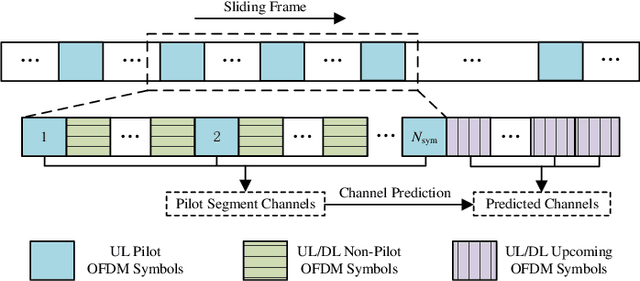

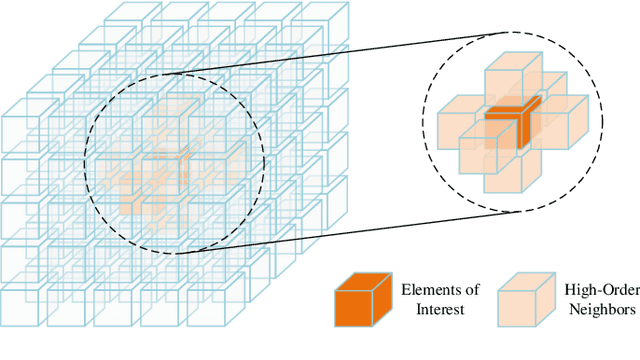
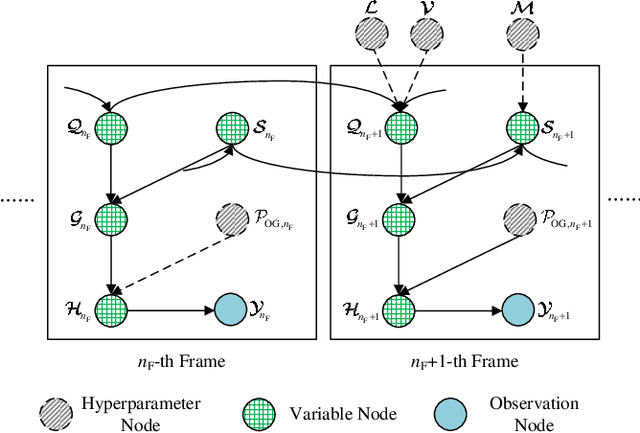
Abstract:In moderate- to high-mobility scenarios, channel state information (CSI) varies rapidly and becomes temporally non-stationary, leading to significant performance degradation in channel reciprocity-dependent massive multiple-input multiple-output (MIMO) transmission. To address this challenge, we propose a tensor-structured approach to dynamic channel prediction (TS-DCP) for massive MIMO systems with temporal non-stationarity, leveraging dual-timescale and cross-domain correlations. Specifically, due to the inherent spatial consistency, non-stationary channels on long-timescales are treated as stationary on short-timescales, decoupling complicated correlations into more tractable dual-timescale ones. To exploit such property, we frame the pilot symbols, capturing short-timescale correlations within frames by Doppler domain modeling and long-timescale correlations across frames by Markov/autoregressive processes. Based on this, we develop the tensor-structured signal model in the spatial-frequency-temporal domain, incorporating correlated angle-delay-Doppler domain channels and Vandermonde-structured factor matrices. Furthermore, we model cross-domain correlations within each frame, arising from clustered scatterer distributions, using tensor-structured upgradations of Markov processes and coupled Gaussian distributions. Following these probabilistic models, we formulate the TS-DCP as the variational free energy (VFE) minimization problem, designing trial belief structures through online approximation and the Bethe method. This yields the online TS-DCP algorithm derived from a dual-layer VFE optimization process, where both outer and inner layers leverage the multilinear structure of channels to reduce computational complexity significantly. Numerical simulations demonstrate the significant superiority of the proposed algorithm over benchmarks in terms of channel prediction performance.
Joint User Scheduling and Precoding for RIS-Aided MU-MISO Systems: A MADRL Approach
Oct 25, 2024Abstract:With the increasing demand for spectrum efficiency and energy efficiency, reconfigurable intelligent surfaces (RISs) have attracted massive attention due to its low-cost and capability of controlling wireless environment. However, there is still a lack of treatments to deal with the growth of the number of users and RIS elements, which may incur performance degradation or computational complexity explosion. In this paper, we investigate the joint optimization of user scheduling and precoding for distributed RIS-aided communication systems. Firstly, we propose an optimization-based numerical method to obtain suboptimal solutions with the aid of the approximation of ergodic sum rate. Secondly, to reduce the computational complexity caused by the high dimensionality, we propose a data-driven scalable and generalizable multi-agent deep reinforcement learning (MADRL) framework with the aim to maximize the ergodic sum rate approximation through the cooperation of all agents. Further, we propose a novel dynamic working process exploiting the trained MADRL algorithm, which enables distributed RISs to configure their own passive precoding independently. Simulation results show that our algorithm substantially reduces the computational complexity by a time reduction of three orders of magnitude at the cost of 3% performance degradation, compared with the optimization-based method, and achieves 6% performance improvement over the state-of-the-art MADRL algorithms.
Robust RL with LLM-Driven Data Synthesis and Policy Adaptation for Autonomous Driving
Oct 16, 2024



Abstract:The integration of Large Language Models (LLMs) into autonomous driving systems demonstrates strong common sense and reasoning abilities, effectively addressing the pitfalls of purely data-driven methods. Current LLM-based agents require lengthy inference times and face challenges in interacting with real-time autonomous driving environments. A key open question is whether we can effectively leverage the knowledge from LLMs to train an efficient and robust Reinforcement Learning (RL) agent. This paper introduces RAPID, a novel \underline{\textbf{R}}obust \underline{\textbf{A}}daptive \underline{\textbf{P}}olicy \underline{\textbf{I}}nfusion and \underline{\textbf{D}}istillation framework, which trains specialized mix-of-policy RL agents using data synthesized by an LLM-based driving agent and online adaptation. RAPID features three key designs: 1) utilization of offline data collected from an LLM agent to distil expert knowledge into RL policies for faster real-time inference; 2) introduction of robust distillation in RL to inherit both performance and robustness from LLM-based teacher; and 3) employment of a mix-of-policy approach for joint decision decoding with a policy adapter. Through fine-tuning via online environment interaction, RAPID reduces the forgetting of LLM knowledge while maintaining adaptability to different tasks. Extensive experiments demonstrate RAPID's capability to effectively integrate LLM knowledge into scaled-down RL policies in an efficient, adaptable, and robust way. Code and checkpoints will be made publicly available upon acceptance.
Meta-Learning Empowered Graph Neural Networks for Radio Resource Management
Aug 29, 2024



Abstract:In this paper, we consider a radio resource management (RRM) problem in the dynamic wireless networks, comprising multiple communication links that share the same spectrum resource. To achieve high network throughput while ensuring fairness across all links, we formulate a resilient power optimization problem with per-user minimum-rate constraints. We obtain the corresponding Lagrangian dual problem and parameterize all variables with neural networks, which can be trained in an unsupervised manner due to the provably acceptable duality gap. We develop a meta-learning approach with graph neural networks (GNNs) as parameterization that exhibits fast adaptation and scalability to varying network configurations. We formulate the objective of meta-learning by amalgamating the Lagrangian functions of different network configurations and utilize a first-order meta-learning algorithm, called Reptile, to obtain the meta-parameters. Numerical results verify that our method can efficiently improve the overall throughput and ensure the minimum rate performance. We further demonstrate that using the meta-parameters as initialization, our method can achieve fast adaptation to new wireless network configurations and reduce the number of required training data samples.
GRLinQ: An Intelligent Spectrum Sharing Mechanism for Device-to-Device Communications with Graph Reinforcement Learning
Aug 18, 2024



Abstract:Device-to-device (D2D) spectrum sharing in wireless communications is a challenging non-convex combinatorial optimization problem, involving entangled link scheduling and power control in a large-scale network. The state-of-the-art methods, either from a model-based or a data-driven perspective, exhibit certain limitations such as the critical need for channel state information (CSI) and/or a large number of (solved) instances (e.g., network layouts) as training samples. To advance this line of research, we propose a novel hybrid model/datadriven spectrum sharing mechanism with graph reinforcement learning for link scheduling (GRLinQ), injecting information theoretical insights into machine learning models, in such a way that link scheduling and power control can be solved in an intelligent yet explainable manner. Through an extensive set of experiments, GRLinQ demonstrates superior performance to the existing model-based and data-driven link scheduling and/or power control methods, with a relaxed requirement for CSI, a substantially reduced number of unsolved instances as training samples, a possible distributed deployment, reduced online/offline computational complexity, and more remarkably excellent scalability and generalizability over different network scenarios and system configurations.
Invariant Correlation of Representation with Label
Jul 01, 2024Abstract:The Invariant Risk Minimization (IRM) approach aims to address the challenge of domain generalization by training a feature representation that remains invariant across multiple environments. However, in noisy environments, IRM-related techniques such as IRMv1 and VREx may be unable to achieve the optimal IRM solution, primarily due to erroneous optimization directions. To address this issue, we introduce ICorr (an abbreviation for \textbf{I}nvariant \textbf{Corr}elation), a novel approach designed to surmount the above challenge in noisy settings. Additionally, we dig into a case study to analyze why previous methods may lose ground while ICorr can succeed. Through a theoretical lens, particularly from a causality perspective, we illustrate that the invariant correlation of representation with label is a necessary condition for the optimal invariant predictor in noisy environments, whereas the optimization motivations for other methods may not be. Furthermore, we empirically demonstrate the effectiveness of ICorr by comparing it with other domain generalization methods on various noisy datasets.
Towards Unified AI Models for MU-MIMO Communications: A Tensor Equivariance Framework
Jun 13, 2024Abstract:In this paper, we propose a unified framework based on equivariance for the design of artificial intelligence (AI)-assisted technologies in multi-user multiple-input-multiple-output (MU-MIMO) systems. We first provide definitions of multidimensional equivariance, high-order equivariance, and multidimensional invariance (referred to collectively as tensor equivariance). On this basis, by investigating the design of precoding and user scheduling, which are key techniques in MU-MIMO systems, we delve deeper into revealing tensor equivariance of the mappings from channel information to optimal precoding tensors, precoding auxiliary tensors, and scheduling indicators, respectively. To model mappings with tensor equivariance, we propose a series of plug-and-play tensor equivariant neural network (TENN) modules, where the computation involving intricate parameter sharing patterns is transformed into concise tensor operations. Building upon TENN modules, we propose the unified tensor equivariance framework that can be applicable to various communication tasks, based on which we easily accomplish the design of corresponding AI-assisted precoding and user scheduling schemes. Simulation results demonstrate that the constructed precoding and user scheduling methods achieve near-optimal performance while exhibiting significantly lower computational complexity and generalization to inputs with varying sizes across multiple dimensions. This validates the superiority of TENN modules and the unified framework.
Continuous Geometry-Aware Graph Diffusion via Hyperbolic Neural PDE
Jun 03, 2024
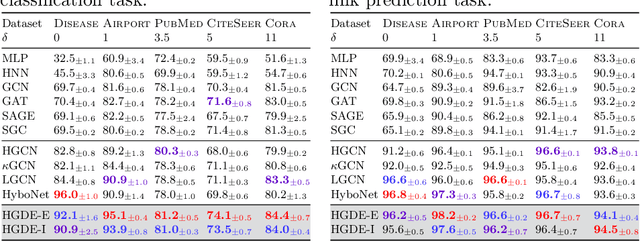

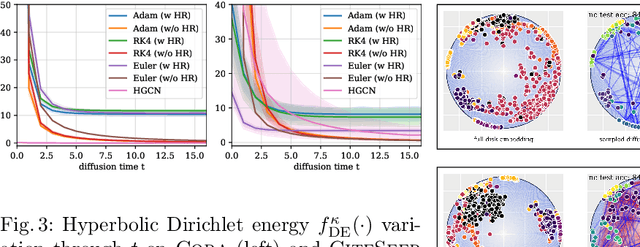
Abstract:While Hyperbolic Graph Neural Network (HGNN) has recently emerged as a powerful tool dealing with hierarchical graph data, the limitations of scalability and efficiency hinder itself from generalizing to deep models. In this paper, by envisioning depth as a continuous-time embedding evolution, we decouple the HGNN and reframe the information propagation as a partial differential equation, letting node-wise attention undertake the role of diffusivity within the Hyperbolic Neural PDE (HPDE). By introducing theoretical principles \textit{e.g.,} field and flow, gradient, divergence, and diffusivity on a non-Euclidean manifold for HPDE integration, we discuss both implicit and explicit discretization schemes to formulate numerical HPDE solvers. Further, we propose the Hyperbolic Graph Diffusion Equation (HGDE) -- a flexible vector flow function that can be integrated to obtain expressive hyperbolic node embeddings. By analyzing potential energy decay of embeddings, we demonstrate that HGDE is capable of modeling both low- and high-order proximity with the benefit of local-global diffusivity functions. Experiments on node classification and link prediction and image-text classification tasks verify the superiority of the proposed method, which consistently outperforms various competitive models by a significant margin.
 Add to Chrome
Add to Chrome Add to Firefox
Add to Firefox Add to Edge
Add to Edge